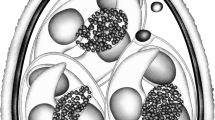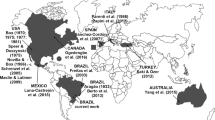Abstract
New Zealand native passerines are hosts to a large variety of gastrointestinal parasites, including coccidia. Coccidian parasites are generally host-specific, obligate intracellular protozoan parasites. In passerine birds, members of the genus Isospora are most common. Under natural conditions, these parasites seldom pose a threat, but stressors such as quarantine for translocation, overcrowding, or habitat changes may cause an infection outbreak that can severely affect wild populations. Although coccidia are important pathogens and have caused mortalities in kiwi (Apteryx spp.) and hihi (Notiomystis cincta), their prevalence, epidemiology, life cycles, and taxonomic relationships are still widely unknown in native New Zealand songbirds. Over a period of 3 years (2007–2009), we examined 330 fecal samples of six native passerine species: tui (Prosthemadera novaeseelandiae), North Island saddleback (Philesturnus carunculatus rufusater), North Island robin (Petroica longipes), silvereye (Zosterops lateralis), and fantail (Rhipidura fuliginosa). The overall prevalence by flotation of coccidian infection in the New Zealand bird species examined was 21–38 %, 21 % in North Island robin, 38 % in tui, and 25 % in saddleback. Similar to prior studies in other countries, preliminary sequencing results suggest that coccidia in passerines in New Zealand are members of the family Eimeriidae, unlike the phenotypically similar genus Cystisospora of mammals. Using molecular methods, we identified at least five new genetically distinct Isospora species in the examined birds (three in tui and one each in saddlebacks and North Island robins).







Similar content being viewed by others
References
Alley MR (2002) Avian wildlife diseases in New Zealand: current issues and achievements. NZVJ 50:118–120
Augustine PC (1996) Avian Eimeria species: effect of prior or simultaneous inoculation of one species on cellular invasion by a second species in vivo and in vitro. Avian Dis 40:783–787
Augustine PC (1999) Prior or concurrent exposure to different species of avian Eimeria: effect on sporozoite invasion and chick growth performance. Avian Dis 43:461–468
Ball SJ, Brown MA, Daszak P, Pittilo RM (1998) Atoxoplasma (Apicomplexa: Eimeriorina: Atoxoplasmatidae) in the greenfinch (Carduelis chloris). J Parasitol 84:813–817
Ball SJ, Brown MA, Snow KR (2012) A new species of Isospora (Apicomplexa: Eimeriidae) from the greenfinch Carduelis chloris (Passeriformes: Fringillidae). Parasitol Res 111:1463–1466
Barta JR, Schrenzel MD, Carreno RA, Rideout BA (2005) The genus Atoxoplasma (Garnham 1950) as a junior objective synonym of the genus Isospora (Schneider 1881) species infecting birds and resurrection of Cystoisospora (Frenkel 1977) as the correct genus for Isospora species infecting mammals. J Parasitol 91:726–727
Berto BP, Flausino W, McIntosh D, Teixeira WL, Lopes CWG (2011) Coccidia of New World passerine birds (Aves: Passeriformes): a review of Eimeria Schneider, 1875 and Isospora Schneider, 1881 (Apicomplexa: Eimeriidae). Sys Parasitol 80:159–204
Box ED (1977) Life-Cycles of 2 Isospora species in canary, Serinus canarius Linnaeus. J Protozool 24:57–67
Carreno RA, Barta JR (1999) An eimeriid origin of isosporoid coccidia with stieda bodies as shown by phylogenetic analysis of small subunit ribosomal RNA gene sequences. J Parasitol 85:77–83
Cassey PE, John G (2008) Relationships between nestling condition and variability in coccidian prevalence among three species of wild-nesting birds in NZ. Aust J Zool 56:75–78
Cringoli G, Quesada A (1991) Isospora mcquistioni and Isospora bioccai (Apicomplexa, Eimeriidae)—2 new coccidian parasites from Carduelis sinica (Passeriformes, Fringillidae). J Protozool 38:577–580
Dolnik OV, Palinauskas V, Bensch S (2009) Individual oocysts of Isospora (Apicomplexa: Coccidia) parasites from avian faeces: from photo to sequence. J Parasitol 95:169–174
Dorrestein GM, Kummerfeld N (1998) Singvögel-Endoparasiten. In: Gabrisch K, Zwart P (eds) Krankheiten der Heimtiere. Schlütersche Verlag, Hannover
Hale KA, Birskie JV (2009) Rapid recovery of an island population of the threatened South Island Saddleback Philesturnus c. carunculatus after a pathogen outbreak. Bird Conserv Int 19:239–253
Higgins D, Thompson J, Gibson T, Thompson JD, Higgins DG, Gibson TJ (1994) ClustaW: improving the sensitivity of progressive multiple sequence alignment through sequence weighting, position- specific gap penalties, and weight matrix choice. Nucleic Acid Res 22:4673–4680
Horak P, Saks L, Karu U, Ots I, Surai PF, McGraw KJ (2004) How coccidian parasites affect health and appearance of greenfinches. J Anim Ecol 73:935–947
Keeler SP, Yabsley MJ, Gibbs SEJ, McGraw SN, Hernandez SM (2012) A new Isospora species of passerines in the family Turdidae from Costa Rica. J Parasitol 98:167–169
Melville DS (2007) New Zealand national bird banding scheme—bird bander's manual DOCDM-285890 (vol. Version 2007(1)
Misof K (2004) Diurnal cycle of Isospora spp. oocyst shedding in Eurasian blackbirds (Turdus merula). Can J Zool 82:764–768
Parker KA (2008) Translocations: providing outcomes for wildlife, resource managers, scientists, and the human community. Restor Ecol 16(2):204–209
Perrott JK (2001) The ecology of Aspergillus fumigatus and implications for wildlife conservation in modified environments. MSc thesis. Massey University, Palmerston North
Ritchie BW, Harrison GJ, Harrison LR (1994) Avian medicine: principles and application. Wingers Publishing Inc., Florida, Lake Worth
Ronquist F, Huelsenbeck JP (2003) MrBayes 3: Bayesian phylogenetic inference under mixed models. Bioinformatics 19:1572–1574
Schnitzler BE, Thebo PL, Mattsson JG, Tomley FM, Shirley MW (1998) Development of a diagnostic PCR assay for the detection and discrimination of four pathogenic Eimeria species of the chicken. Avian Pathol 27:490–497
Schrenzel MD, Maalouf GA, Gaffney PM, Tokarz D, Keener LL, McClure D (2005) Molecular characterization of isosporoid coccidia (Isospora and Atoxoplasma spp.) in passerine birds. J Parasitol 91:635–647
Swofford DL (2002) PAUP*: Phylogenetic analysis using parsimony (and other methods) 4.0 Beta, Version 10
Thompson EJ (1978) Coccidiosis in Kiwis. NZVJ 26:167
Thorne JM (2007) An experimental approach to the translocation of the North Island saddleback (Philesturnus carunculatus rufusater) to Bushy Park Reserve, Wanganui. PhD thesis. Massey University, Palmerston North
Twentyman CM (2001) A study of coccidial parasites in the hihi (Notiomystis cincta). MVSc thesis, Massey University, Palmerston North
Acknowledgments
The authors would like to thank Te Arawa Iwi for access to Mokoia Island, Steve Trewick and his team for help in the lab, as well as the residents of Wildbase at Massey University/Palmerston North for providing clinical history. We acknowledge the outstanding technical help from staff at the Institute of Veterinary, Animal and Biomedical Sciences, including Barbara Adlington, Anne Tunnicliffe, Elaine Booker, Evelyn Lupton, and Nicola Wallace. The authors thank Christy Getzlaff for the drawing of Fig. 2. Funding for this study was received from the IVABS Research Fund for Postgraduate Students to Ellen Schoener, Massey University Research Fund and DoC to Laryssa Howe and Isabel Castro, and indirectly by Biosecurity NZ through contract 10424/2 to Isabel Castro.
Author information
Authors and Affiliations
Corresponding author
Rights and permissions
About this article
Cite this article
Schoener, E.R., Alley, M.R., Howe, L. et al. Coccidia species in endemic and native New Zealand passerines. Parasitol Res 112, 2027–2036 (2013). https://doi.org/10.1007/s00436-013-3361-z
Received:
Accepted:
Published:
Issue Date:
DOI: https://doi.org/10.1007/s00436-013-3361-z




